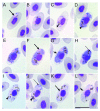Molecular characterization and morphological description of cryptic haemoproteids in the laughingthrushes (Leiothrichidae) in the western and eastern Himalaya, India
- PMID: 30450425
- PMCID: PMC6221074
- DOI: 10.12688/wellcomeopenres.14675.1
Molecular characterization and morphological description of cryptic haemoproteids in the laughingthrushes (Leiothrichidae) in the western and eastern Himalaya, India
Abstract
Background: Laughingthrushes (family: Leiothrichidae) consists of diverse and widespread species found in the Indian subcontinent but there is a lack of information on their avian haemosporidians. Methods: We sampled 231 laughingthrushes of 8 species in the western and eastern Himalaya in India. Using parasite morphology and cytochrome b sequences we describe 2 new Haemoproteus species harbored in 3 species of laughingthrushes and report a case of cryptic speciation. Results: First Haemoproteus lineage TROERY01 (GenBank: KY623720) found in Trochalopteron erythrocephalum (27.47%) and Trochalopteron variegatum (2.9%) in mid to high altitude tropical forests in the western and eastern Himalaya, was described as Haemoproteus (Parahaemoproteus) leiothrichus n. sp. (Haemosporida: Haemoproteidae). Second Haemoproteus lineage TROERY02 (GenBank: KY623721) described as Haemoproteus (Parahaemoproteus) homoleiothrichus n. sp. (Haemosporida: Haemoproteidae) was found in T. erythrocephalum (2.19%) and Trochalopteron lineatum (3.84%), albeit in low intensity, only in the western Himalaya. Both H. homoleiothrichus n. sp. and H. leiothrichus n. sp. showed no significant difference in morphological features in blood stages. A genetic divergence of 4.4% along with distinct phylogenetic position indicates that these 2 lineages represent cryptic species. Previously, T. erythrocephalum has been described as an additional host for a morphologically described Haemoproteus timalus in the oriental region. Our described species have several morphological features that are absent in H. timalus. These are, the presence of dumbbell-like shaped mature gametocytes, 'arm' like extensions of gametocytes and lateral displacement of nuclei of infected erythrocytes. Illustrations of blood stages of the new species are given, and phylogenetic analysis with morphologically described Haemoproteus species identifies parasites closely related to the 2 described parasites. Conclusions: The lineages described here have been recorded only in the laughingthrushes so far. These are the first parasites to be described with T. erythrocephalum as a type host from the western and eastern Himalaya in India.
Keywords: Haemoproteus; India; Laughingthrushes; cryptic species.
Conflict of interest statement
No competing interests were disclosed.
Figures





Similar articles
-
Keys to the avian Haemoproteus parasites (Haemosporida, Haemoproteidae).Malar J. 2022 Sep 19;21(1):269. doi: 10.1186/s12936-022-04235-1. Malar J. 2022. PMID: 36123731 Free PMC article. Review.
-
Molecular characterization of six widespread avian haemoproteids, with description of three new Haemoproteus species.Acta Trop. 2019 Sep;197:105051. doi: 10.1016/j.actatropica.2019.105051. Epub 2019 Jun 8. Acta Trop. 2019. PMID: 31181190
-
Two new species of Haemoproteus Kruse, 1890 (Haemosporida, Haemoproteidae) from European birds, with emphasis on DNA barcoding for detection of haemosporidians in wildlife.Syst Parasitol. 2014 Feb;87(2):135-51. doi: 10.1007/s11230-013-9464-1. Epub 2014 Jan 29. Syst Parasitol. 2014. PMID: 24474037
-
New avian Haemoproteus species (Haemosporida: Haemoproteidae) from African birds, with a critique of the use of host taxonomic information in hemoproteid classification.J Parasitol. 2011 Aug;97(4):682-94. doi: 10.1645/GE-2709.1. Epub 2011 Mar 2. J Parasitol. 2011. PMID: 21506819
-
Haemoproteus cyanomitrae sp. nov. (Haemosporida: Haemoproteidae) from a widespread African songbird, the olive sunbird, Cyanomitra olivacea.J Parasitol. 2010 Feb;96(1):137-43. doi: 10.1645/GE-2198.1. J Parasitol. 2010. PMID: 19691417
Cited by
-
Keys to the avian Haemoproteus parasites (Haemosporida, Haemoproteidae).Malar J. 2022 Sep 19;21(1):269. doi: 10.1186/s12936-022-04235-1. Malar J. 2022. PMID: 36123731 Free PMC article. Review.
References
-
- Atkinson CT, Van Riper C, III: Pathogenicity and epizootiology of avian haematozoa: Plasmodium, Haemoproteus, and Leucocytozoon . In Bird-parasite interactions: Ecology, evolution, and behavior.Oxford University Press, London, U.K.,1991;19–48. Reference Source
-
- Bennett GF, Bishop MA, Peirce MA: The species and distribution of the haemoproteids of the avian family Muscicapidae sensu latu (Passeriformes). J Nat Hist. 1991;25(1):23–43. 10.1080/00222939100770041 - DOI
Grants and funding
LinkOut - more resources
Full Text Sources

